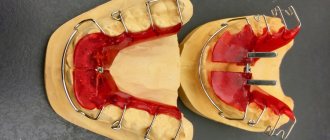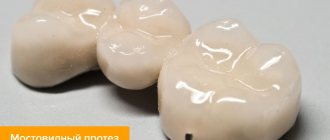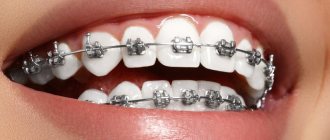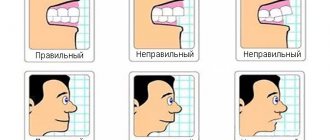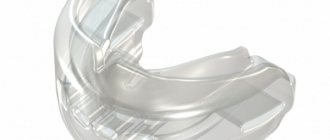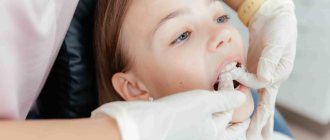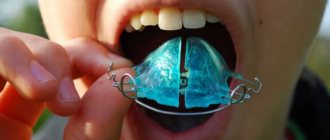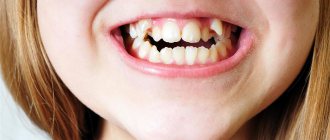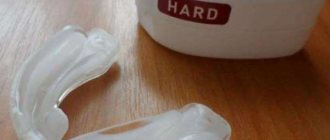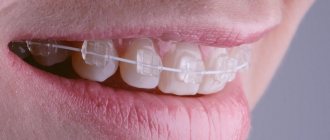A plate for straightening teeth (bracket) looks like a small arch of wire that wraps around the outside of the teeth. This is a removable or non-removable complex orthodontic structure that is installed on the jaw in order to correct aesthetic defects and restore chewing function in case of its impairment or loss.
The device works by applying pressure to the bone tissue. As treatment progresses, the screws will need to be periodically tightened to maintain the therapeutic effect. As a result, in a year or two you can have an attractive, even smile.
What is the name of the teeth straightening plate? The doctor will understand the patient, no matter how he expresses himself. Braces are often confused with retainers, but these designs have slightly different functions.
Indications for use
The device is installed if necessary:
- prevent possible displacement of teeth, keep them in the correct, natural position;
- adjust the shape of the jaw bones or the width of the palate;
- expand interdental distances, get rid of crowding (in children);
- consolidate the result after wearing braces;
- slow down bone growth.
There are also contraindications, but they are few:
- severe mental disorders;
- some respiratory tract disorders;
- allergy to the metal from which the device is made;
- exacerbation of periodontal diseases.
If the oral cavity is not sanitized, there are caries, problems with the gums, the enamel looks bad: before you start wearing a child or adult plate to straighten teeth, you need to get rid of concomitant diseases.
What sensations may you feel while wearing braces?
The essence of the process of correcting occlusion anomalies is that, under the pressure of a power arc, the teeth begin to move in a given direction. In this case, the bone tissue of the jaw begins to dissolve on one side and grows on the other. This process is accompanied by the response of nerve endings, the signal from which is sent to the brain. As a result, the person feels a pain reaction. We can conclude that pain during treatment is natural. Therefore, you should not be afraid of her. Over time, the body adapts: the pain will either stop altogether or will be felt as a slight discomfort.
When is the best time to bet
The device is used both at a young and at a more mature age, depending on the needs of the client. If there are no significant jaw defects and only supportive or consolidating therapy is required, such a design can be used in adult patients, but they are given only non-removable versions - the removable version does not provide sufficient pressure on the formed dentition to keep it in its normal position.
When are plates placed to straighten children’s teeth, how are they made, what are they called and what are they needed for? The optimal option is considered to be 5–6 years old; sometimes the device is installed on children (3–4 years old), but the final decision is made only by the dentist. It is popular to use a lightweight orthodontic device instead of braces in adolescence, up to 12 (less often up to 15–16) years - mainly to correct minor malocclusions and alignment problems.
In adulthood, dental correction is performed using more complex systems or aligners, but there are cases when the use of arches is prescribed for adults.
A little about why the bite can form incorrectly and how to avoid it:
What results can be achieved?
Sometimes the use of plates in childhood precedes the subsequent installation of braces. However, in most cases, with the help of such orthodontic appliances, it is possible to avoid treatment with fixed structures or make it shorter.
The sooner you start correcting your bite, while the dentition is easily corrected, the greater the likelihood of a complete recovery.
In adults, the result, at first glance, is less noticeable. Especially when the plates are used as retainers, holding teeth in the correct position after removing the braces. However, these structures prevent repeated changes in the bite and allow a person to live a full life .
Types of designs
What types of plates are there for straightening teeth (in particular for children), what are they called and what do they look like? There are several types of dental braces - they are selected by the doctor during a preliminary examination, depending on the severity and nature of the defects, as well as the characteristics of the patient’s lifestyle.
The main classification is the division into removable and non-removable devices. Removable ones are not as effective as fixed ones, but are more convenient to use - you don’t have to wear them when they cause severe inconvenience, you don’t need to eat in them, and you can easily remove them for cleaning or tightening.
Fixed
These dental plates look almost like braces and are metal arches equipped with locks.
They are installed in adults to correct the straightness of the dentition. Depending on the need, the dentist may suggest one of the following options:
- Single-jaw - in them the design is supplemented with one or more screws, which are tightened from time to time. They are used if the dentition is shortened or narrowed.
- With retraction arch on a plastic base. The wire springs, creating the desired effect. Such a device can be installed on both the upper and lower jaw to correct its frontal part.
- With a hand-shaped process, the function of which is to apply pressure on the dental neck for greater efficiency. Used to correct individual visible defects.
- Bruckle's apparatus. This plate for straightening teeth looks like a regular brace, but it is additionally equipped with an inclined plane and a spring arch.
- Andresen-Goipl activator. It is used in pediatric dentistry when bone tissue is not growing fast enough by stimulating its growth. Able to correct bite.
- Frenkel apparatus (also helps young patients), consisting of cheek shields, lip pads (for lip retraction) and a durable frame. Designed to correct defects in the anterior part of the jaws.
Removable
These structures are simpler than non-removable ones and are usually made of plastic; the function of fasteners is performed by metal hooks, and sometimes there are additional screws and springs. Correcting teeth with plates that can be removed usually takes longer, and they are used only in simple cases when a significant change in the condition of the dentition is not required. Such devices are worn mainly by children, often as rehabilitation after more serious orthodontic treatment with braces (instead of retainers).
Types for adults
In most cases, adult patients are prescribed single-jaw plates. Occasionally, arm-shaped structures may also be used.
Single jawed
The plate base of the structure is supplemented with special orthodontic screws. When tightened, they allow the device to exert directed and adjusted pressure. mainly used for narrowed or shortened dentition , as well as in case of deformation of some teeth.
photo: colored single-jaw plates
The cost depends on the number of screws with which the structure is equipped. A plate with one screw costs about 7–9 thousand rubles, and each screw costs from 1000 to 1300 rubles.
With retraction type arc
It consists of the retraction arch itself (vestibular, that is, external) and the obligatory plastic base. The operating principle of this device is based on the fact that the wire included in the structure can spring. Due to this, the position of the teeth during a protrusive bite is corrected.
photo: plate with retraction type arc
Estimated cost – 7000 rubles.
With a hand-shaped process
The basis of the design - the plate base - is complemented by a hand-shaped process, which is used to exert pressure on the required tooth in the area of its neck for greatest efficiency . The action is based on the elasticity of the wire from which the appendage is made.
photo: plate with a hand-shaped process
The approximate price is about 7 thousand. At the same time, the cost of manufacturing one appendage is about 400 rubles.
Bruckle apparatus
The base is the same plate base for the lower jaw. It is complemented by an inclined plane in the area of the anterior teeth and the retraction arch. Makes it possible to move the front teeth using the masticatory muscles and a springy retraction arch.
photo: trouser apparatus
Price – about 10 thousand rubles.
Differences between removable and permanent braces
The first can be considered a lightweight option. Such arcs:
- cheaper than those that cannot be removed independently;
- not very effective for noticeable problems, more suitable for maintenance therapy.
What does a removable dental plate look like? This is a structure made of soft plastic, it is attached to metal hooks by the teeth. Children's options are often decorated with sparkles or made colorful to make them more pleasant for the child to use.
An undoubted advantage is that this option can not be worn all the time, getting rid of the device during meals, and in some cases during sleep (as prescribed by a doctor). However, they need to be used as often as possible, otherwise there will be no visible effect: sometimes even a break of one day significantly complicates the treatment.
Preparation before orthodontic treatment
At the first appointment with a doctor, an examination of the oral cavity, an x-ray examination and an impression of the dentition are made.
Before any orthodontic appliance is placed in the mouth, the teeth must be prepared. Damaged areas must be removed, those teeth that have minor damage must be treated. It is not easy to carry out these procedures on a child. We can treat and remove teeth for children under anesthesia. Under the supervision of a qualified anesthesiologist, the doctor will treat all the teeth quickly and at one time.
At the next visit to the orthodontist (usually after 1-2 weeks), the plate is installed. This procedure takes about 10 minutes. The correction of the bite there : once every few months it is necessary to visit the attending physician for preventive examinations, as well as for correction of the orthodontic structure
Installation
Before an impression of the teeth is made for the plates and they are placed (put on), the patient undergoes a complete dental and orthodontic examination, including x-rays of the entire jaw. Afterwards, plaster models are individually made, on the basis of which the arches are made. The structure of the oral cavity of each patient is unique, and it is impossible to use braces created for one person in the treatment of another. The base of the structure should tightly grip the gums and dental contour, and the structure itself should securely fix the device in the desired position, applying pressure to the places that require correction.
What is better or worse than braces?
It is hardly worth comparing braces and orthodontic plates, since they perform different functions and have different indications for installation . At the same time, we can name the advantages and disadvantages of the plates, which will help many patients make their choice.
Advantages:
- the possibility of installation in childhood, when the jaw system is not yet fully formed;
- often shorter wearing period;
- removable design gives more freedom and comfort to the patient;
- do not cause pain.
Flaws:
- cannot be used in complex cases of malocclusion;
- it is not possible to make precise adjustments to the position of each tooth;
- cannot always help adult patients, since their tooth mobility is greatly reduced due to the completion of the formation of the dentofacial system.
How to use a dental plate correctly
The system must be cleaned regularly - the formation of plaque and stone on it leads to inflammation and the development of caries. If you are using a removable version, leave it in a disinfectant solution about once a week overnight.
If the design requires a screw, it must be tightened and lubricated as necessary.
If the braces are removed, it is permissible to remain without them only during meals and daily hygiene (sometimes also during sleep), even if they cause discomfort: without constant impact on the jaw there will be no desired effect. Before a person, especially a child, gets used to the plates on their teeth, they need an adaptation period - on average, one and a half to two weeks. However, there should not be severe pain and friction: if they are observed, you should contact your dentist.
If problems arise with the device, you must immediately make an appointment with an orthodontist, since a break in treatment can negatively affect its outcome. Often, fixing the problem is not difficult (only a specialist should do this), but in some cases it is necessary to completely replace the structure.
How to relieve pain - recommendations from dentists
Experts from the “Smile” dental network, based on their practical experience, advise:
- Before going to the procedure for installing braces, you need to get a good night's sleep, have a hearty snack in advance, and not worry. If you still have anxiety, you can take a light sedative;
- when wearing a brace system at the initial stage, in order to minimize friction of the lips and tongue on the structural elements, it is recommended to use specialized wax for braces;
- to eliminate pain while eating, foods should be cut finely and not eat hard foods;
- If pain interferes with your normal routine, you can take painkillers. But their use should not be constant.
Important:
sensations at all stages of treatment are purely individual. Therefore, only an orthodontist can give correct advice based on a specific clinical situation.
Photos before and after wearing a dental plate - what the result of treatment looks like
Treatment of malocclusion or dentition is not a quick process, but the result speaks for itself. For example, here are the “after” photos.
What is such a device?
An orthodontic plate is a special device that corrects bite and dental defects in children. It is able to completely replace braces in children's practice. The plates are used in children from six to twelve years of age. In adults, they are used extremely rarely, as they are not able to have the necessary effect on the formed jaw. Titanium alloys and polymers are used to manufacture corrective devices.
They must meet certain parameters:
- stability of the structure, which helps maintain the previously specified shape after any deformation;
- must be durable, safe, and not provoke allergies;
- made individually for each patient.
The orthodontist decides which design will be used to correct the anomalies. It determines the position of structural elements. He decides which area of the jaw is affected to correct the bite, where fasteners are installed for comfortable removal and donning.
How long to wear the design
Before the doctor installs plates on the teeth of children or when he places them on adults, he makes a preliminary calculation of the time it will take to treat the pathology. This period is approximate and can be reduced or increased depending on the individual reaction and speed of curvature correction. On average, a non-removable system is worn for a year or two, followed by the installation of a retainer to consolidate the result (it is used for as long as possible). If the arch is installed for a child whose jaw is at the stage of formation, most likely, the device will require replacement approximately every six months.
To obtain accurate information on how long and how to wear dental plates correctly, you need to see at least the first results of treatment.
How to Care for Braces
The basic principle of caring for fixed arches is thorough cleaning several times a day using a brush and floss (dental floss). In the case of removable ones, the process is a little more complicated. Necessary:
- When eating, remove the system, after (before putting it on) - thoroughly clean and rinse the mouth;
- do not forget about weekly deep cleaning of the device using special solutions and gels;
- Strictly follow the dentist’s recommendations regarding the regular use of the device - depending on the severity of the pathology and design features, you need to wear it for several hours a day.
If the arc is equipped with a screw, it should be regularly treated with vegetable oil to prevent it from stagnating, and then carefully turned clockwise and counterclockwise.
For children
How to wear a dental plate for a child depends on the age at which it is placed. Here, too, you need to listen to your specialist. The parents’ task is to ensure that their son or daughter puts on the device on time and does not take it off without the knowledge of their elders (for example, at school or kindergarten). In the event of a breakdown, you should immediately consult a doctor for repair or replacement.
A child's jaw needs less time to change, so the screw will have to be tightened more often than in the case of an adult patient. It is important to monitor uniform pressure on the dentition and control the degree of bite correction.
A plate for a child’s teeth may differ in design from the “adult” version - they are made in color and the metal is decorated with sparkles. Due to this, children's devices are often more expensive than conventional ones, but this can be justified: if you make the medical device an analogue of jewelry, it will be easier for the little patient to get used to it, and he will become less capricious from the need to wear an orthodontic device in his mouth.
For adults
People over 16 years of age are most often given not lightweight thin arches, but braces or aligners that resemble sports mouth guards (if a removable option is needed), but there are situations when the doctor chooses braces - usually this happens if the patient does not require extensive treatment. It is easier for an adult than for children to explain how to properly put a plate on their teeth and remove it, how it works - in the future it is enough just to follow these recommendations and not forget about hygiene.
Device and principle of operation
Despite the existing differences in the structure of orthodontic plates, they all have a similar design and main structural components. The base is a plastic base. It is connected in a certain way to metal arches of various configurations.
It is these arcs that serve as the main acting force for adjustment. In addition, the design also includes fasteners that serve to hold the plate in the correct position on the patient's jaw. Fastenings can be in the form of hooks.
In some types, in addition to this, a special screw is also required, which activates the device using a key.
The principle of action is to apply constant, low-intensity pressure to the dentition, returning it to the correct position or preventing the situation from getting worse.
Children's dental roots cannot be damaged because the pressure is very low.
Retention devices after removing braces
Even high-quality orthodontic intervention is not a guarantee that after the correction is completed, the situation will not return to its original course and the curvature will not return. To minimize the risk of this, after wearing the system (usually one and a half to two years), supporting and consolidating therapy is used, since the elements of the jaw retain increased mobility and tend to return to their old position. Typically the process lasts several years, 1.5-2 times longer than treatment - this is exactly what a dental plate is for.
The use of an arch does not involve such discomfort as the use of a brace system, and after it, the result will be almost unnoticeable. Also, it will not cause inconvenience to a person who is accustomed to careful oral care.
Not only wire elements can be used as a retainer, but also mouth guards that are placed on the teeth. The number of hours in a day during which a retention device must be worn is determined by the doctor based on the mobility of the patient’s jaw.
Is it painful to wear?
Patients do not experience severe pain even during the adaptation period - for several days while they get used to the orthodontic apparatus. However, many may experience quite severe discomfort. In this case, discomfort is almost always associated with the presence of a foreign solid object in the mouth.
Basically, all unpleasant sensations go away in a maximum of a week and a half. However, in cases where wearing is not indicated constantly, but only for a certain number of hours during the day, addiction can extend over a longer period.
Advantages and disadvantages of records
The advantages of fixed orthodontic braces include:
- effectiveness against malocclusions, gaps, grouping;
- relatively low cost;
- no need for active patient action (especially important for children - it is enough to follow simple operating instructions);
- the ability to save the entire row without removing the “extra”, as before braces;
- expansion of the jaw (in children), so that subsequently the permanent incisors and molars erupt correctly and do not interfere.
Before you start wearing dental plates, you should familiarize yourself with the list of potential inconveniences:
- ineffective for significant pathologies;
- the possibility of an allergic reaction to plastic or metal alloy components;
- risk of gum inflammation (in this case, consultation with the treating orthodontist is required);
- discomfort when wearing (especially initially);
- the likelihood of a change in diction (the patient will have to adapt to the new state and not plan important meetings during the adaptation period);
- lack of aesthetic appeal (it is better to find out in advance everything about the condition of the teeth and clarify what a dental plate looks like for a child or adult).
How effective are the devices?
If the problem is not advanced, arches are enough to get an even, beautiful smile and get rid of defects. Only an orthodontist can give the most accurate forecast - he will also advise which device should be chosen.
The best option is to use the design at a young age, as this reduces the likelihood that repeated correction will be needed after adulthood. The doctor will select the optimal wire thickness to achieve the effect.
How to install?
After the initial examination, an x-ray is taken, without which it is impossible to prescribe the wearing of orthodontic appliances . If it is necessary to use orthodontic plates for correction, the doctor follows a certain algorithm.
- Before installation, the plate must be manufactured. Since these devices must be strictly individual, it is necessary to make an impression of both jaws of the patient.
- A primary model is then made from plaster and tried on to eliminate even the most minor discrepancies.
- The model serves as the basis for the manufacture of both the plastic base of the plate and other parts. The shape of the plastic should repeat in great detail all the individual features of the palate, as well as the contours of the teeth and gums.
- The penultimate stage is the fitting of the finished product, based on the results of which the doctor can make its correction.
- Since the plates are removable structures, their direct installation does not cause problems. However, the first installation at the dentist's office is important, as the dentist will teach you how to put on and take off the appliance yourself so as not to damage it or harm your teeth.
Cost of dental plates
For a minor citizen of Russia, the service can be provided free of charge upon presentation of a compulsory medical insurance policy - this is included in the territorial program of state guarantees for the provision of medical care (although sometimes you have to wait). Before children have plates placed on their teeth, impressions are taken of them.
In different commercial organizations, the price varies from 7–10 to 30 thousand rubles, depending on the configuration and complexity of the case. Some devices can be more expensive than conventional arches: for example, a Frenkel apparatus can cost up to 22 thousand, and a single-jaw design can cost differently depending on the number of screws in it.
Specialists at the Dentika clinic invite patients for consultations and installation of orthodontic systems that correct the bite and dentition. We will tell you in detail about how it works, looks, is called and what a plate does for straightening teeth for children and adults, what type of bite it is placed on, and we will help you choose an option that suits you. We work in Voronezh 7 days a week and are always ready to provide qualified assistance!
Types for children
For children's teeth, all types and types of structures that are listed above are used.
Frenkel apparatus
Consists of plastic lip pads and cheek shields (2 of each element). They are connected using a durable metal frame, which can take the form of a palatal clasp, lingual or vestibular arch. Moves the anterior teeth using a springy retraction arch and masticatory muscles.
photo: Frenkel apparatus
Price – from 11.5 to 22 thousand rubles.
Andresen-Goipl activator
Consists of two base plates connected into a single block. May have screws, retraction arch, and other components. Helps activate jaw growth if necessary, uncouples the bite, and also returns individual teeth to their correct position.
photo: andresen-goipl activator
Price – from 12 thousand rubles.
The cost of each type in this case may be even higher than for plates for adults. This occurs due to the child’s choice of the pattern configuration and the variety of colors that will be present on the plate base of the device.
Modern technologies make it possible not only to make the plate itself multi-colored, you can also add glitter, all kinds of decorations and designs to the plastic.
The average cost of a plate for one jaw will be about 8 thousand rubles. But a simple plate for one jaw without additional functional elements, such as screws, costs about 3-4 thousand.
